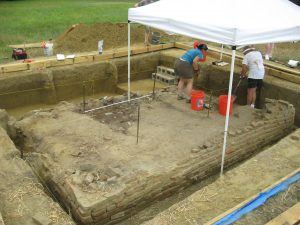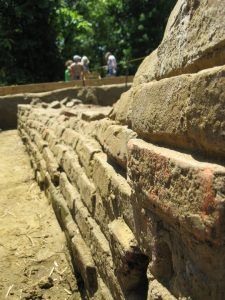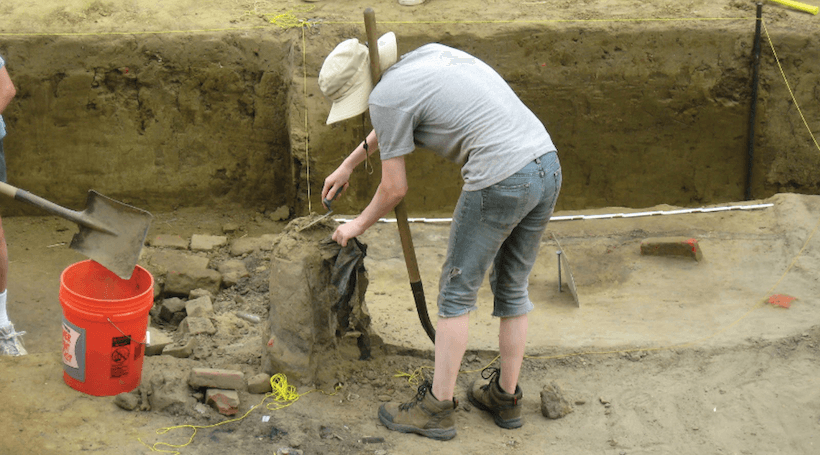The excavated area in Westampton measures just 6 feet by 15 feet – roughly the size of a small bedroom – but inside the trench lay thousands of clues: broken medicine bottles, empty peanut butter jars and bent Civil War-era buttons. All signs of what life was once like in the village of Timbuctoo.
Now beneath a grassy meadow near Rancocas Creek, Timbuctoo was once a thriving settlement – and an important stop on the Underground Railroad – that was founded by free African Americans and escaped slaves in the 1820s.
Researchers don’t know if the name Timbuctoo was chosen by those who founded the village or by the Quakers in the area, who most likely offered assistance to them.
At its height in the mid-nineteenth century, Timbuctoo was home to over 150 residents and contained more than a dozen homes, a school, a church and a cemetery where 13 graves of African American troops from the Civil War are still marked by worn headstones.
The community thrived until about 1930, when residents began moving away to find jobs during the Great Depression. As they left, the buildings deteriorated over the years and were eventually razed, leaving only traces of the residents’ lives buried beneath the soil.
“Today,” former Westampton Mayor Sidney Camp says, “so many people in Burlington County are amazed that this site – which is one of the most important African American historical sites in the state – is basically in their backyard.”
Laying the groundwork
Years before the first shovel hit the ground at the site, Camp was working to understand Timbuctoo and the history it holds. “I had learned about Timbuctoo through friends, and I felt very compelled to do more research about the settlement,” he says.


The university’s team, led by grad student Chris Barton, conducted a ground sonar survey to better determine what – if any – artifacts remained. “The survey would help us pinpoint the precise location of the dig, rather than us just going in and dropping a shovel,” explains Barton.
The survey findings were better than Barton and Camp even imagined. “When I saw the survey, I came running out of my office. It showed roughly 13 anomalies, which we knew could possibly be foundations of homes. It was a huge discovery,” says Barton.
That fall, Barton and a crew of Temple archaeology students carefully dug out test pits surrounding one of the structures identified on the survey. The site crew named the structure Feature 13, and through research were able to determine that it was possibly the foundation of the home once belonging to Timbuctoo’s Davis family.
“We found documentation showing that David Davis actually served in the Civil War in one of the regiments of the United States Colored Troops. He and his wife, Rebecca, purchased the lot in 1879 for $2 and then built a home and raised children there. Having that tie to a specific family made Feature 13 even more interesting – and important – to the dig,” says Barton.
After just two days of meticulous excavation, the crew uncovered a wall. “It was then that we knew how well preserved the area was,” explains Barton. “It was amazing.”
Assembling a team
Following the successful discovery of Feature 13, Barton and his team, along with Camp and other Westampton officials, invited Timbuctoo descendants to join what they now call the Timbuctoo Discovery Project.
“By encouraging them to be a part of the dig, everyone here would better understand the importance and meaning of Timbuctoo,” says Barton. “Their presence and input has made it much more intimate than the typical dig.”
Nearly a dozen descendants joined the project, along with a number of nearby residents who were interested in the activity going on at the site.
“This has been different from a lot of other archaeological digs,” explains Camp. “There’s never been a velvet rope keeping people at arm’s length. We want people in the community to actively participate in the dig. Timbuctoo holds lessons that are of benefit to everyone. So far, we’ve had people ranging from 5 to 80 years old help us.”
Launching the dig
With the team in place, Barton was able to undertake the excavation of Feature 13. “We started with the corners and the eastern portion of the structure as seen on the survey. We were able to determine that it had been a 16-foot by 12-foot structure – keep in mind that this would have been home to a family of seven,” says Barton.
“We were also able to see that the bricks were very poor quality, but that proves that the residents did the best they could with what they had,” he adds. Through research, the team has been able to establish that the bricks they’ve found are throwaways from the Quaker brickyard that used to operate down the road, where many Timbuctoo residents worked.
“Not surprisingly, the residents of Timbuctoo were at the lower end of the economic spectrum. They had to deal with Jim Crow, they had to deal with slavery, they had to deal with economic oppression, racism,” says Barton. “That’s what we really set out to find at the dig – not just artifacts, but the story behind the artifacts.”
Piecing together the past
Thanks to the nearly 20,000 artifacts uncovered from the site thus far, Barton and his fellow archaeologists have slowly been able to see how the residents survived – and even thrived – in Timbuctoo, despite racism and discrimination.


“But other items we’ve found, like children’s marbles and a doll tea set and even display objects like a plate with a flower design, show us that some families also had the means for non-essentials. Not everyone who lived here was impoverished. There’s a lot you can learn and deduce from every artifact, no matter how insignificant it may seem at first.”
As excavation at the site continues, many of the artifacts are still being cleaned and indexed by researchers at Temple. While they continue to analyze and piece together their understanding of what life was like for the residents of Timbuctoo, Camp is working to have the former village recognized as a national historic site.
“It’s something we’re looking in to, but in the meantime I have helped secure an agreement with the state to grant an easement around the site, which means nothing can be developed in that area,” he says. “There are also some ideas on how we can eventually display the artifacts recovered from the site. Timbuctoo and the story of the people here deserve to be honored.”










